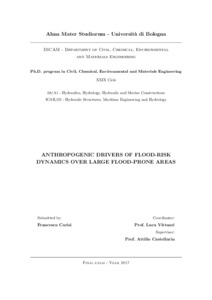Carisi, Francesca
(2017)
Anthropogenic Drivers of Flood-Risk Dynamics over Large Flood-Prone Areas, [Dissertation thesis], Alma Mater Studiorum Università di Bologna.
Dottorato di ricerca in
Ingegneria civile, chimica, ambientale e dei materiali, 29 Ciclo. DOI 10.6092/unibo/amsdottorato/8168.
Documenti full-text disponibili:
![[img]](http://amsdottorato.unibo.it/8168/7.hassmallThumbnailVersion/Carisi_Francesca_Dissertation_XXIX_cicle.pdf)  Anteprima |
|
Documento PDF (English)
- Richiede un lettore di PDF come Xpdf o Adobe Acrobat Reader
Disponibile con Licenza: Salvo eventuali più ampie autorizzazioni dell'autore, la tesi può essere liberamente consultata e può essere effettuato il salvataggio e la stampa di una copia per fini strettamente personali di studio, di ricerca e di insegnamento, con espresso divieto di qualunque utilizzo direttamente o indirettamente commerciale. Ogni altro diritto sul materiale è riservato.
Download (74MB)
| Anteprima
|
Abstract
Flood risk assessment and management witnessed an extremely significant improvement during the last two decades pro-actively responding to the increasing impact of floods worldwide and to the promulgation of the European Flood Directive 2007/60/EC. In spite of these efforts, the uncertainties associated with all components of flood risk (hazard, exposure and susceptibility) are still high and several open problems still need to be accurately investigated. Addressing three different Italian case studies, this Dissertation aims at shedding some light on the most important flood risk related issues for which current literature seems to be still sparse. Concerning flood hazard, we investigates the role of different human-induced drivers and showed that the influence of anthropogenic land-subsidence near the city of Ravenna is definitely less important than the impact of the linear infrastructures in altering the flooding dynamics. With regard to flood exposure, we proposes an innovative simplified tool proving to be reliable to assess how and where a specific land-use class developed over time. By adopting these tools we investigated the evolution of exposure of residential sector over the entire floodplain of the middle-lower portion of the Po river during the last 50 years, showing that the expected economic damages in case of a catastrophic flood event doubled during this time span. Finally, focusing on flood susceptibility, we collected and analysed damage data for a real inundation event of January 2014 concerning the Secchia river to develop uni- and multi-variate damage models for flood losses evaluation. Their performance was compared with the one of widely used literature models, pointing out that the latter, originally developed for specific contexts, should not be exported to different contexts. The multi-variate approach slightly outperforms the uni-variate one. Furthermore, our results highlight the need for a comprehensive collection of post-event data, aiming at validating existing models.
Abstract
Flood risk assessment and management witnessed an extremely significant improvement during the last two decades pro-actively responding to the increasing impact of floods worldwide and to the promulgation of the European Flood Directive 2007/60/EC. In spite of these efforts, the uncertainties associated with all components of flood risk (hazard, exposure and susceptibility) are still high and several open problems still need to be accurately investigated. Addressing three different Italian case studies, this Dissertation aims at shedding some light on the most important flood risk related issues for which current literature seems to be still sparse. Concerning flood hazard, we investigates the role of different human-induced drivers and showed that the influence of anthropogenic land-subsidence near the city of Ravenna is definitely less important than the impact of the linear infrastructures in altering the flooding dynamics. With regard to flood exposure, we proposes an innovative simplified tool proving to be reliable to assess how and where a specific land-use class developed over time. By adopting these tools we investigated the evolution of exposure of residential sector over the entire floodplain of the middle-lower portion of the Po river during the last 50 years, showing that the expected economic damages in case of a catastrophic flood event doubled during this time span. Finally, focusing on flood susceptibility, we collected and analysed damage data for a real inundation event of January 2014 concerning the Secchia river to develop uni- and multi-variate damage models for flood losses evaluation. Their performance was compared with the one of widely used literature models, pointing out that the latter, originally developed for specific contexts, should not be exported to different contexts. The multi-variate approach slightly outperforms the uni-variate one. Furthermore, our results highlight the need for a comprehensive collection of post-event data, aiming at validating existing models.
Tipologia del documento
Tesi di dottorato
Autore
Carisi, Francesca
Supervisore
Dottorato di ricerca
Ciclo
29
Coordinatore
Settore disciplinare
Settore concorsuale
Parole chiave
flood-risk; flood-hazard; flood-exposure; flood-susceptibility; flood-damage; anthropogenic flood-hazard alterations; inundation modelling; flood exposure evolution; damage models; large scale flood risk management
URN:NBN
DOI
10.6092/unibo/amsdottorato/8168
Data di discussione
17 Maggio 2017
URI
Altri metadati
Tipologia del documento
Tesi di dottorato
Autore
Carisi, Francesca
Supervisore
Dottorato di ricerca
Ciclo
29
Coordinatore
Settore disciplinare
Settore concorsuale
Parole chiave
flood-risk; flood-hazard; flood-exposure; flood-susceptibility; flood-damage; anthropogenic flood-hazard alterations; inundation modelling; flood exposure evolution; damage models; large scale flood risk management
URN:NBN
DOI
10.6092/unibo/amsdottorato/8168
Data di discussione
17 Maggio 2017
URI
Statistica sui download
Gestione del documento:


 Login
Login
